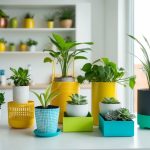How to Make Your Own Cleaning Products: Simple and Cost-Effective Methods
Recipes for Difficult Surfaces
Cleaning tough surfaces like wood, stainless steel, tiles, grout, granite, and marble in your home requires particular care and specialized recipes to ensure they remain in good condition. Learn how to create effective, homemade cleaning solutions that target these areas specifically.
Wood and Stainless Steel
Wood surfaces, being porous, need a gentle yet effective cleaner. A mix of 1 cup of water, 1 cup of white vinegar, and a few drops of olive oil works well. This solution cleans without causing damage. Apply lightly with a soft cloth and ensure even coverage.
For stainless steel appliances, combine 1 cup of water with 1 cup of rubbing alcohol, adding a few drops of essential oil for scent. Mist the solution onto the surface and wipe down with a microfiber cloth to avoid streaks. Always wipe in the grain’s direction to maintain the stainless steel’s finish.
Tiles and Grout
Tiles and grout can accumulate grime that regular cleaners might miss. For a powerful homemade cleaner, mix 1/2 cup of baking soda with 1/4 cup of hydrogen peroxide and 1 teaspoon of dish soap. Apply this paste to grout lines and leave it for about ten minutes before scrubbing with a stiff brush.
For tile floors, a solution of 1/2 cup of white vinegar, 1/2 cup of distilled water, and a few drops of dish soap provides excellent cleaning power. Mop the floor with this mixture to lift dirt and leave tiles sparkling clean. Rinse with water afterward to prevent any soapy residue.
Granite and Marble Care
Granite and marble counters require special attention to prevent etching and staining. A mix of 1/2 cup of rubbing alcohol, 1/2 cup of water, and a few drops of mild dish soap creates an effective cleaner. Spray onto the surface and gently wipe with a soft cloth. Avoid using acidic substances like vinegar or lemon, as these can damage stone surfaces.
For stubborn spots, a paste made of baking soda and water can be applied directly. Let it sit for a few minutes and then gently scrub and rinse. Always dry these surfaces with a clean cloth to preserve their natural shine and finish.
Eco-Friendly Fresh Scents
Creating your own cleaning products allows you to choose eco-friendly, natural scents. Essential oils and citrus fruits like lemon and orange are excellent for this. They not only provide pleasant aromas but also possess cleaning properties.
Using Essential Oils Wisely
Essential oils such as tea tree oil, lavender, and peppermint are popular for their fresh scents and antibacterial qualities. When used correctly, they can enhance the efficacy of your cleaning products. For instance, tea tree oil is known for its antiseptic properties, making it a top choice for disinfecting surfaces.
Lavender brings a calming fragrance but is also effective in repelling insects. Peppermint oil, with its refreshing smell, can be mixed with vinegar and water to clean windows and mirrors. It’s crucial to use these oils in moderation. Too much can overpower the senses or cause irritation, so always follow recommended dilution guidelines. Typically, a few drops per bottle of cleaning solution suffice.
The Power of Citrus
Citrus fruits, particularly lemon and orange, offer an excellent way to add fresh scents to your homemade cleaning products. Lemon juice is effective at cutting through grease, making it ideal for kitchen surfaces. It also has natural antibacterial qualities, which help keep your home germ-free.
Orange oil can be obtained from the peel and used similarly. It brings a pleasant, uplifting aroma and works well in removing sticky residues and polishing wooden surfaces. Mix citrus juices or oils with baking soda for a multi-purpose cleaner that works on sinks, toilets, and countertops. Always test on a small area first to avoid any potential surface damage.



